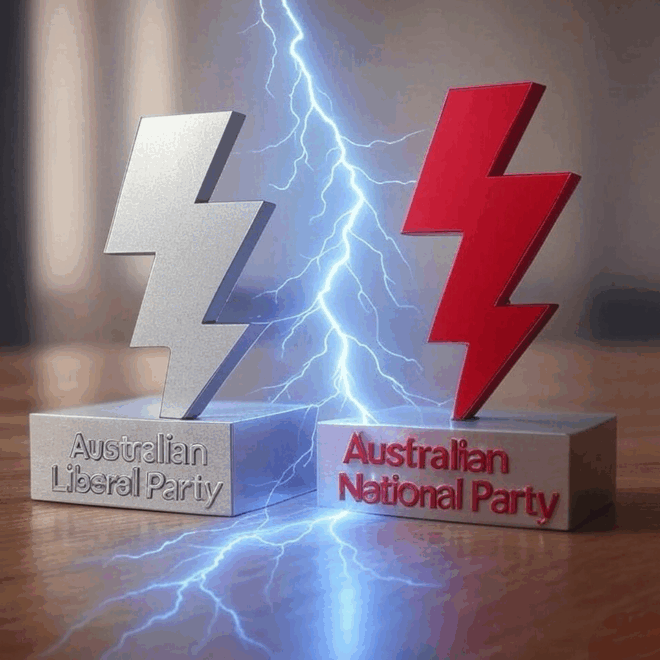
Introduction
The Liberal Party of Australia, once a stalwart of the Coalition alongside the National Party, is currently grappling with a significant crisis in New South Wales (NSW). Membership has plummeted dramatically from approximately 13,000 in 2023 to a mere 6,000 by 2025. This alarming decline is not merely a statistic; it coincided with the Coalition’s catastrophic defeat in the May 2025 federal election, where the party secured only 43 seats nationally, suffering losses in urban NSW constituencies. A notable example is the loss of the Bradfield seat, which fell to independent candidate Nicolette Boele by a razor-thin margin of 40 votes. The situation reached a breaking point on May 20, 2025, when the Coalition dissolved following Nationals leader David Littleproud’s announcement that the party would not renew its longstanding agreement with the Liberals, effectively ending a partnership that had endured since 1987.
This post delves into the multifaceted causes behind the Liberal Party’s membership collapse in NSW, examining internal dysfunction, ideological shifts, electoral setbacks and external pressures. It further analyses the implications of this decline, the loss of key seats like Bradfield and the impact of the Coalition split. Finally, it evaluates whether the party’s rightward shift has rendered it unelectable and proposes strategies for recovery, with a strong emphasis on grassroots revitalisation to rebuild the party’s foundation.
Causes of the Membership Collapse
Factional Conflicts and Leadership Instability
The Liberal Party in NSW has been plagued by factional disputes, particularly between its moderate and conservative wings. These internal conflicts have significantly eroded trust within the party. The preselection delays during the 2022 federal election, particularly in crucial seats like Warringah and Parramatta, led to the federal executive appointing candidates for nine seats (Eden-Monaro, Fowler, Grayndler, Greenway, Hughes, McMahon, Newcastle, Parramatta and Warringah effectively sidelining local branches. This decision angered moderates in urban areas and prompted numerous resignations. Under Peter Dutton’s conservative leadership since 2022, the party alienated urban voters who prioritise climate action. The aftermath of the 2025 election loss saw Sussan Ley narrowly defeating conservative Angus Taylor for the leadership, with Jacinta Nampijinpa Price supporting Taylor’s right-leaning agenda. The absence of a unifying leader has exacerbated factional rifts, overshadowing the concerns of voters.
Preselection Disputes and Grassroots Disengagement
Controversies surrounding preselection processes have further fuelled the decline in membership. In the 2022 election, the Liberal Party did not parachute candidates into Bradfield, where incumbent Paul Fletcher faced a tough challenge from Nicolette Boele. In Warringah, the selection of Katherine Deves by the federal executive ignited backlash and allegations of “branch stacking” in Western Sydney eroded trust. The 2025 preselection in Bradfield, which saw Gisele Kapterian defeat Warren Mundine, also resulted in resignations. The party’s failure to nominate 164 candidates for local elections in 2024 across 16 councils cost it up to 50 seats, leading to the dismissal of state director Richard Shields. Urban branches are now reporting low engagement, with younger members increasingly defecting to Teal independents.
Financial and Organisational Weakness
The loss of 7,000 members has severely impacted the party’s fundraising capabilities. New electoral funding laws, which took effect in July 2025, cap campaign spending, further exacerbating the financial strain. The 2025 campaign has been described as a “comprehensive failure” by Senator Linda Reynolds, largely due to poor strategy and execution. The debacle in the 2024 local elections underscored the party’s incompetence, prompting further defections.
Rightward Ideological Shift
Dutton’s leadership has seen a pronounced emphasis on conservative policies, such as nuclear power, which clashes with the climate priorities of urban NSW voters. The Marine Conservation Society has linked the 2025 electoral loss to the party’s rejection of nuclear plans. The party’s wavering stance on net zero has frustrated moderates within its ranks. Ley’s willingness to abandon net zero risks alienating even more voters. In constituencies like Wentworth and Bradfield, moderate branches favour progressive policies, but Dutton’s conservative approach has pushed them away. Calls from figures like Andrew Bragg for a centrist shift highlight the party’s internal ideological struggles, with the loss of Bradfield serving as a stark indicator of moderate defections.
Disconnect with Diverse Voters
The Liberal Party’s disconnect with younger and more diverse voters has been stark. In the 2025 election, Gen Z and millennials overwhelmingly backed Labor, with only 26% of Gen Z supporting the Coalition. Additionally, diverse communities in Western Sydney showed a strong preference for Labor. The party’s conservative policies have alienated these groups, while women demonstrated a clear preference for Labor, with 55% supporting the opposition, reflecting dissatisfaction with male-dominated pre-selections.
Electoral Setbacks
2022 and 2025 Federal Election Losses
The Liberal Party suffered significant losses in the 2022 federal elections, with key NSW seats falling to Teal independents and Labor. In Bradfield, Paul Fletcher’s margin shrank from 16.6% to just 4.2% against Boele. The 2025 election was even more devastating, with the Liberals managing to hold only four Greater Sydney seats after the narrow loss of Bradfield, which is now subject to a recount. The defeats in Banks and Hughes further signify an urban collapse.
2023 NSW State Election
Labor’s victory in the 2023 state election under Chris Minns marked the end of the Liberal government, further eroding confidence in the Party.
Competition from Teals and Labor
The rise of Teal independents has resulted in the capture of traditional Liberal strongholds. In Bradfield, Boele’s victory in 2025 was aided by a redistribution that favoured her candidacy, while Labor’s 30 seats in NSW during the same election cycle placed additional pressure on the Liberals in key areas like Lindsay.
Scandals
The Liberal Party’s reputation in NSW has also been tarnished by scandals, most notably Scott Morrison’s 2022 secret ministries debacle. Unsubstantiated reports of branch stacking in Western Sydney in 2025 have only fuelled perceptions of corruption, further damaging the party’s standing.
The Coalition Split
The Coalition’s dissolution on May 20, 2025, marked a significant turning point for the Liberal Party. Littleproud’s announcement that the Nationals would not renew their agreement was rooted in disputes over critical issues such as nuclear power and rural services. The Nationals’ stronger performance in the 2025 election starkly contrasted with the Liberals’ losses, highlighting the growing tensions within the Coalition. Matt Canavan’s leadership challenge within the Nationals underscored these divisions. The split has weakened the Liberal Party’s electoral strategy, as preference exchanges with the Nationals had previously been crucial for their success.
Consequences
Electoral Challenges
The membership collapse and the split from the Coalition have severely crippled the Liberal Party’s prospects in NSW. The loss of 7,000 members has diminished their campaigning capabilities and without the Nationals’ preferences, the party struggles to remain competitive, holding only four Greater Sydney seats.
Ideological Struggles
The leadership battle between Ley and Taylor highlights the ongoing ideological divides within the party. Ley’s conservative stance may limit her appeal to moderates, while the Nationals’ departure forces the Liberals to establish a distinct identity.
Existential Threat
Prominent party figures like Karen Andrews and Helen Coonan have warned of an “existential crisis.” The low representation of women and the failure to connect with diverse voter demographics pose significant threats to the party’s viability moving forward.
Is the Liberal Party Unelectable?
While the Liberal Party is not permanently unelectable, it faces substantial challenges:
• Urban Weakness: The party’s retention of only four Greater Sydney seats after the loss of Bradfield reflects a significant failure to connect with urban voters amid competition from Teals and Labor.
• Demographic Disconnect: The party’s inability to appeal to Gen Z, millennials, women and diverse voters has become increasingly evident, with these groups showing strong support for Labor and Teal independents.
• Policy Needs: Calls from moderates like Bragg for a centrist platform highlight the urgent need for the party to adapt its policies to attract a broader voter base.
• Recovery Challenges: Historical precedents suggest that Ley’s path to recovery may be fraught with difficulties.
Recovery Strategies
To reverse the membership decline, reclaim Bradfield and navigate the post-Coalition landscape, the Liberal Party must undertake significant reforms, focusing particularly on grassroots revitalisation:
1. Reform Preselection Processes: Implementing transparent preselection processes can help rebuild trust within the party. The recent Bradfield contest demonstrated the value of local input. Mandatory branch votes with oversight can prevent issues like stacking and encourage member retention.
2. Adopt a Centrist Policy Platform: Embracing a centrist platform that prioritises renewable energy and childcare can help attract urban voters. A commitment to achieving net zero by 2050, coupled with investments in solar energy, can counter the appeal of Teal candidates in seats like Bradfield. Additionally, childcare subsidies can resonate with families, aligning the party’s policies with the priorities of NSW residents.
3. Increase Female and Diverse Representation: Actively recruiting female and diverse candidates is crucial for rebuilding trust with disenfranchised voter groups. Setting a target of 50% female candidates by 2028 and engaging with Western Sydney’s diverse communities can foster greater representation.
4. Revitalise Grassroots Engagement: Reinvigorating local branches is essential to reversing membership decline, especially in urban NSW. The party should implement a comprehensive strategy:
• Community Engagement Programs: Hosting regular town hall meetings focused on climate issues and housing can help re-engage voters. Initiatives like a “Community Day” in Bradfield, featuring policy discussions and family-friendly activities, can foster a sense of belonging and encourage new sign-ups. Collaborating with local businesses for charity drives can strengthen community ties and demonstrate commitment to local priorities.
• Youth Recruitment Initiatives: Establishing a “Liberal Youth” initiative with university chapters at institutions like Sydney and Macquarie can attract younger voters. Organising debates, guest speaker events and internship opportunities can engage students on pressing issues like jobs and climate change, countering the digital advantage held by Teal candidates. Utilising social media platforms like Instagram and TikTok for outreach can amplify these efforts.
• Hybrid Engagement Models: Combining virtual meetings with in-person canvassing can maintain member engagement. Monthly livestreamed Q&A sessions with MPs can include remote members, while door-knocking efforts in Bradfield can gather valuable feedback. A “Liberal Listens” campaign can pair physical outreach with online surveys to better understand voter concerns.
• Branch Empowerment and Training: Establishing a “Grassroots Growth Fund” to allocate resources for branch-led workshops can equip members with the skills needed for effective campaigning. Training sessions on digital campaigning and organising can prepare members to compete with Teal independents. In Western Sydney, participating in multicultural festivals can engage diverse communities and promote inclusivity.
• Membership Incentives: Offering discounted event tickets, exclusive policy briefings and preselection voting rights can enhance member retention. Recognising outstanding volunteers with a “Liberal Champion” award in Bradfield can incentivise activism and engagement.
5. Counter Teal Appeal: Developing policies that address climate change and gender equity, such as committing to 50% renewable energy by 2030, can help the party reclaim Teal seats. Supporting community-led climate initiatives can rebuild trust among voters in Bradfield.
6. Adapt to Post-Coalition Landscape: Exploring preference deals with the Nationals or Teals can help maintain electoral viability. Forming alliances with housing advocacy groups can broaden the party’s appeal and relevance.
Conclusion
The Liberal Party’s membership collapse in NSW can be attributed to a combination of factional conflicts, preselection disputes, a rightward ideological shift, electoral losses and damaging scandals. The failure of a parachute candidate in Warringah in 2022, along with preselection delays and local election failures, has exacerbated the crisis. The loss of Bradfield, coupled with the defeats in the 2022 and 2023 elections and the Coalition split in May 2025, poses significant challenges for the party’s future.
While the Liberal Party is not irreversibly unelectable, it faces an “existential crisis” that demands immediate attention. By reforming preselection processes, adopting a centrist policy platform, increasing diversity, revitalising grassroots engagement, countering the appeal of Teal independents and adapting to the post-Coalition landscape, the party can work towards rebuilding its base. Grassroots revitalisation through community engagement, youth programs and hybrid models is critical for the party’s recovery. Failure to address these issues may result in a prolonged period of opposition, diminishing the party’s influence in Australian politics.

